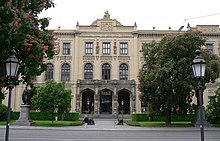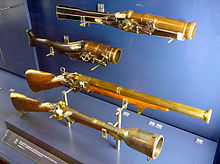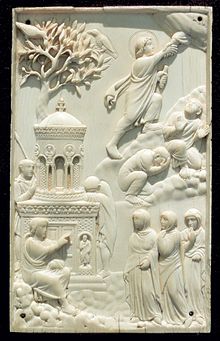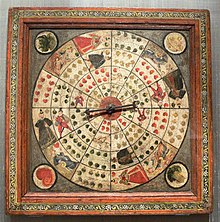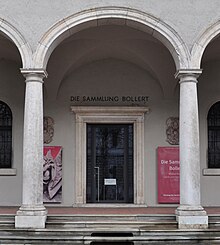Bavarian National Museum
 Bavarian National Museum (central building), 2013 |
|
| Data | |
|---|---|
| place | Munich |
| Art |
Art and cultural history museum
|
| architect | Gabriel von Seidl |
| opening | September 29, 1900 (building at Prinzregentenstrasse 3); Foundation of the museum: 1855 |
| Number of visitors (annually) | 146,000 (2015) |
| operator | |
| management | |
| Website | |
| ISIL | DE-MUS-097014 |
The Bavarian National Museum in Munich houses an art and cultural history collection on around 13,000 m² . His collection, which mainly includes regional and European sculptures and handicrafts , not only had an educational mandate for broad sections of the population from the beginning, but was also set up to train the craftsmen. Today the main and eastern upper floors offer a historical tour from the early Middle Ages to the beginning of the 20th century. The folklore department with the famous crib collection is presented in the basement .
history
Beginnings
The museum was founded in the middle of the 19th century on the personal initiative of King Maximilian II . In 1851 the King had visited the Great Exhibition in London and witnessed the beginnings of the South Kensington Museum . In 1853, on his behalf, archive director Karl Maria von Aretin , who was preparing a large-scale publication of the art monuments of the Bavarian ruling house, presented plans for the establishment of his own Wittelsbach museum. The monarch determined the final name "Bavarian National Museum" in a personal letter dated June 30, 1855. The external reason for the new institution may have been the founding of the Germanic Museum in Nuremberg in 1852, which Maximilian apparently wanted to counter with his dynastic museum.
The first museum building - today's Museum of Five Continents - was built in a prominent location on the forum on Maximilianstrasse in 1859 and opened in 1867. The document sunk in the foundation stone speaks of an "institution for the storage of the most interesting patriotic monuments and other remains of bygone times". Maximilian's father, Ludwig I , had monumental buildings built for the museums he created, the Glyptothek and the Alte and Neue Pinakothek , in which what, according to the terms of the time, was the highest achievements of European art were kept and venerated: the sculpture of antiquity and painting. The National Museum, which was supposed to have an educational effect in a broader sense, appears as a logical continuation of these previous foundations.
In addition to the history of Bavaria and the Wittelsbach family, which were initially in the foreground, “separate collections” of handicraft objects were also set up. Arranged according to material groups, the objects should serve as inspiration for contemporary artists and craftsmen and provide them with models for their own work.
Soon after it opened in 1867, the Bavarian National Museum on Munich's Maximilianstrasse was able to take on an important position among the state capital's galleries and museums.
The building in Prinzregentenstrasse
The collection, which was already considerable when the Bavarian National Museum on Maximilianstrasse was moved into, grew in the following years due to extensive new additions, so that space in the exhibition rooms became scarce. The museum presentation (the museum didactics ) caused increasing difficulties; Complaints about overcrowding as well as defects in the system and construction of the house became more and more apparent, so that a fundamental renovation was finally carried out around 1890. After a short time, however, it turned out that the problems could only be solved by building a new one.
The new building on Prinzregentenstrasse decided by the state parliament in 1892 was started in 1894 based on a design by Gabriel von Seidl and opened six years later on September 29, 1900. Seidl's National Museum is one of the most important and original museum buildings of its time. The building had to live up to the requirement to contain the most varied of works of art and styles from several centuries. The building program should be based on the exhibits. Seidl achieved this by individually designing the individual parts of the building. The three equally projecting structures, which are connected to each other by transverse structures, were each decorated with their own facade in the style of the German Renaissance, Baroque and Rococo. At the same time, von Seidl renounced excessive monumentality and leanings on sacred buildings, so that there was no representation of state and church and the character of the national, regional and civic was placed in the foreground.
The museum's exhibition rooms are also of different sizes, shapes and decorations. Seidl created changing dimensions and passage axes, which gave every room a new impression. Furthermore, with the support of Rudolph Seitz, he designed the rooms in such a way that there is harmony between the shell, the presentation and the collection items. The spatial overall pictures were arranged thematically and connected the exhibits with suitable furniture and decorative handicrafts. Their sequence resulted in a very lively and varied tour for the visitors. Despite partial redesigns and modernizations, the basic structure of Seidl's conception has been preserved to this day and gives the museum an unmistakable character.
Extensions
As early as 1905/06, the museum was expanded to the north with a few halls and a workshop wing. For the external appearance of greater importance, however, was the wing built in 1937 according to plans by German Bestelmeyer on the southeast corner. At about the same time, the horticultural forum on Prinzregentenstrasse was leveled. At that time, Adolf von Hildebrand's Hubertus Fountain, which is now located at the eastern end of the Nymphenburg Canal in Munich-Neuhausen, was dismantled , and Hildebrand's equestrian monument to the Prince Regent was moved to its current location.
During the Second World War, the museum building was badly damaged by air raids and the halls were repeatedly burned down by incendiary bombs. However, the previous outsourcing of large parts of the collection and the library prevented worse. After the occupation by the Americans, the US military government took over the protection of the rescue sites and banned any unauthorized movement of the art objects. After 1945, efforts at the Bavarian National Museum were aimed at restoring it using the simplest of means, in order to set up the halls again and make them accessible to the public. On April 13, 1947, the first halls on the eastern ground floor were reopened. The collection of the Bavarian Army Museum , which was largely destroyed during the war, also found a temporary home in the National Museum until it moved to Ingolstadt in 1969.
After the first complete renovation in 1973, during which the technical equipment was adjusted, among other things, space problems that occurred again in the 1990s pushed for additional extensions. A spacious new building on Himbselstrasse and Oettingenstrasse accommodated the workshops of the museum craftsmen and the restoration studios. The building, which was moved into in 1999, also houses the Chair of Restoration, Art Technology and Conservation Science at the Technical University , which works closely with the Bavarian National Museum.
The main floor of the west wing of the house was reopened in July 2015 after extensive renovation. Since then, important parts of the inventory such as large baroque sculptures, ivory work , sumptuous furniture and clocks, which were recently only shown in an interim exhibition in the east wing.
Directors
- 1855–1868: Karl Maria Freiherr von Aretin
- 1868–1885: Jakob Heinrich von Hefner-Alteneck
- 1885–1897: Wilhelm Heinrich von Riehl
- 1897–1907: Hugo Graf
- 1907–1908: Georg Hager
- 1909–1914: Hans Stegmann
- 1916–1931: Philipp Maria Halm
- 1932–1947: Hans Buchheit
- 1948–1968: Theodor Müller
- 1968–1974: Hans R. Weihrauch
- 1974–1985: Lorenz Kriss-Rettenbeck
- 1985–1991: Johann Georg Prince of Hohenzollern
- 1991–1999: Reinhold Baumstark
- 1999–2018: Renate Eikelmann
- since July 2018: Frank Matthias Kammel
Permanent exhibition and collections
The Bavarian National Museum comprises exhibition rooms with a total area of around 13,000 square meters on three floors. The basis of the collection comes from the Wittelsbach art collection. It is above all what gives the National Museum its importance beyond the local area. The diversity and breadth of the collection areas were, however, due in particular to the new additions in the subsequent period. To this day, the holdings are continually and systematically supplemented, which is not only done through acquisitions, but also through significant foundations or bequests. The National Museum is supported in particular by the "Friends of the Bavarian National Museum" established in 1960. The oldest exhibits date from late antiquity and the early Middle Ages, while the previous period is presented in the neighboring State Archaeological Collection .
ground floor
The main floor houses valuable paintings, wooden sculptures, bronzes, medieval ivory, tapestries, furniture, weapons and handicrafts from the early Middle Ages to the Enlightenment in an impressive sequence of historical interior design. In particular, the unique and particularly richly represented masterpieces of south German carving art by Hans Multscher , Tilman Riemenschneider , and Hans Leinberger are to be emphasized.
Medieval and Renaissance sculptures
The marble lions from Reichenhall are among the most important works from the Romanesque period. Together with the sculpture collection of the Staatliche Museen zu Berlin , the Bavarian National Museum has the largest collection of German sculptures from the Gothic and Renaissance periods. Most of the works were acquired between 1853 and 1867, almost all of them from the art market. On the other hand, three particularly significant complexes are partly from more recent times. The museum has the only museum collection of large sculptural works by Hans Leinberger , the leading Bavarian carver and sculptor of the Renaissance. It was only built at the beginning of the 20th century, in the heyday of German Expressionism , when people were particularly receptive to Leinberger's sculptures with their expressiveness and the agility of their forms. The holdings of works by the leading Swabian carver of the 15th century, Hans Multscher , and Tilman Riemenschneider from Würzburg have been continuously built up over the century and a half of the museum's existence. For Riemenschneider, the Bavarian National Museum together with the Berlin Sculpture Collection can show the most important group of works.
The figures from the shrine of the Münnerstadt Magdalenian retable from 1490/92, one of Riemenschneider's main works, are of particular importance . Above all, the naked figure of St. Mary Magdalene, covered by hair of varying thickness, shows the full virtuosity of his carving technique. Another key work by the young Riemenschneider are the groups of soldiers and relatives of Jesus from a crucifixion reredos, which were only acquired in 1994. In addition, the exquisite color version of the Rothenburg Franciscan Martinus Schwarz has been preserved almost intact.
Other highlights of the collection are the Mother of God from Seeon Abbey and the shrine figures of the high altar retable of the Freising Cathedral from 1443, works in which the elegant elegance of the soft style (also known as the beautiful or international style), as it had determined the works of the previous generation , is reshaped by a new realism with Dutch influences. The 14th century is represented by several key works that Emperor Ludwig the Bavarian commissioned.
During the Reformation, small sculptures for art-loving patrons replaced church furnishings as the most prominent commissions from sculptors and carvers. Probably the most important representative of this era, the German-Dutch court artist Conrat Meit , is represented in the Bavarian National Museum by a group of particularly exquisite works.
Paintings from the Middle Ages and Renaissance
The Alte Pinakothek had been open to the public since 1836 . Accordingly, the collection of paintings in the Bavarian National Museum is not as systematic as that of the sculptures. Nevertheless, the museum has several hundred paintings from the Middle Ages and Renaissance, and early Bavarian painting cannot be studied anywhere else in such abundance and at such a high level. For the 14th century there is the large panel with the crucifixion and the resurrection of Drusiana from the Munich Augustinian Church , for the middle 15th century the lower register of the tabula magna from Tegernsee Monastery , the main work of the Munich painter Gabriel Angler from 1444/45, a loan from the Bayerische Staatsgemäldesammlungen . At the beginning of the 16th century Jan Polack was the leading painter in Munich. Large parts of his two most important altar works are presented in the church hall of the Bavarian National Museum, the reredos from Munich's Peterskirche and from the Munich Franciscan Church, which was demolished in 1802.
The main works of Swabian and Franconian painting of the 15th and 16th centuries are exhibited in the branch museums of the Bavarian National Museum in Kempten and Kronach . In the main building in Munich, however, the large reredos from the Bamberg Franciscan Church from 1429, the Artelshofen family altar by Wolf Traut from the Nuremberg Lorenz Church and the Haunstetten epitaph by the Ulm master of the Sterzing Altar Wings, who worked closely with Hans Multscher , and two very high-quality altar wings remain by Bernhard Strigel .
Many paintings were taken over from the state painting collections, but others were also acquired privately. A major work of Bohemian painting around 1400, the so-called Pähler Altar, was discovered in 1857 by the school teacher Xaver Kratzer von Beuerberg near Wolfratshausen in the attic of a farm between Weilheim and Pähl . The famous portrait of the court jester Mertl Witz by the Munich court painter Hans Mielich is on loan from the Historical Association of Upper Bavaria.
You can also see historical room ensembles such as the Augsburger Weber Zunftstube and outstanding Gothic cabinets. Major works of ivory art, important glass windows and insignificant evidence of textiles from the Gothic period as well as numerous medals, miniatures, paintings and sculptural sculptures from the Renaissance period complete the collection.
Ivory before 1550
The group of late antique and medieval ivory is relatively small, but has some pieces that are unique worldwide. In addition to several abbot curves from Bavarian monasteries and reliefs from the Magdeburg antependium of Emperor Otto I, a relief from the vicinity of the Western Roman imperial court with one of the oldest depictions of the Ascension of Christ is one of the most famous works in the collection. The so-called Kunigunde box, which was probably created in Denmark around 1000, has a similar rank to this work, known as the Reider table. Together with other masterpieces of ivory carving , the last two works mentioned were acquired in 1860 from the private collection of the Bamberg local researcher Martin von Reider . Reider's collection in particular makes it clear what dangers medieval treasure art was exposed to during the secularization period and what role private collectors played in preserving the remains. In a database coordinated by the Courtauld Institute of Art in London, the Gothic ivory of the Bavarian National Museum will in future be researchable online.
Weapons and armor
The core of the weapons collection goes back to the armor chamber of the Wittelsbach family, which however no longer exists in its entirety. Significant additions from the late 19th century came from Hohenaschau Castle , Ambras Castle and from the gun chamber of the Wittelsbach of the Munich Residence . Various pieces of armor from the 16th and early 17th centuries, individual pieces of armor, including the row of armor from Salzburg Prince Archbishop Wolf Dietrich von Raitenau , polearms and edged weapons , including some unique late-Gothic swords, are exhibited in the large arms hall .
Baroque and Rococo
In addition to state furniture, goldsmithing, weapons, musical instruments, clocks, glasses, miniatures, ivory work and bronze sculptures, the Florentine bronzes of the Medici, including a bronze sculpture of two wrestling wrestlers by Massimiliano Soldani Benzi and a pastel painting by Rosalba Carriera from Venice, are among the most important exhibits . The Rococo is represented by masterpieces of Bavarian Rococo sculpture, including a large number of works by Ignaz Günther and Johann Baptist Straub, some of which are colored, and rare furniture, some of which are exhibited on the upper floor.
Reuschel collection
The Bavarian National Museum owes more than 60 late Baroque oil sketches to the collector and Munich banker Wilhelm Reuschel . With Reuschel's increasing interest in designs for church decorations in the 1930s, his collection grew in size and was finally given to the National Museum on permanent loan in 1959. The idea sketches for large-format ceiling, wall and altar pictures show the development of southern German and Austrian painting in the 18th century. Martin Knoller , Franz Anton Maulbertsch , Franz Joseph Spiegler , Johann Christian Wink and Januarius Zick were among Wilhelm Reuschel's favorite artists.
First floor
The tour through cultural history continues on the eastern upper floor with style epochs from classicism to art nouveau, which are impressively demonstrated by sculptures, furniture, porcelain and glasses.
On the western upper floor, selected specialist departments present the collections of porcelain, musical instruments and games, as well as the silverware of the Hildesheim prince-bishop from the 18th century , which is effectively set up in the clean room .
Ivory after 1550
The collection of post-medieval ivory in the Bavarian National Museum, along with those of the Kunsthistorisches Museum in Vienna and the Green Vault in Dresden as well as a number of other princely collections, is one of the largest and most important of its kind in the world. The holdings range from the 16th to the 19th century with a focus on on the ivory art of the baroque . The baroque ivory, mostly created in the German-speaking area and in the Netherlands, is the most artistically outstanding and quantitatively largest area, as exotic ivory was one of the preferred materials for statuettes and small-format ones from the end of the 16th century to the second half of the 18th century Reliefs, tankards and cups. In addition, the baroque ivory turning works that were never again achieved were virtuoso art chamber pieces that were made on complicated mechanical lathes.
The ivory collection of the Bavarian National Museum goes back to the collections of the Bavarian and Palatinate Wittelsbachers from Munich and Düsseldorf / Mannheim. In accordance with the centuries-old princely origins of a large part of the collection, it has a clearly courtly character, which is reflected in the virtuoso artistic quality and sometimes sought-after uniqueness of its objects. Together with the private ivory collection Mayr from Regensburg acquired by the Bavarian state in 1811 and acquired secularization property, the collections were presented to the public in Munich over the course of the 19th century and transferred to the Bavarian National Museum, which had recently been founded, in 1857, but especially in 1866. Important purchases - such as the group acquired in 1992 with the fling of Marsyas by Adam Lenckhardt - are still made today.
This collection, with around 250 works by leading ivory artists from the 16th to 18th centuries, is expected to be on display again on a large scale from 2017. The unique overview of ivory art ranges from the works of Christoph Angermair , the ivory carver Elector Maximilian I of Bavaria , to the groups of works by Georg Petel , Ignaz Elhafen , Antonio Leoni and Simon Troger , which are only available in Munich to this extent , to the diverse examples of profane and sacred works by various European ivory artists.
Games
The collection of games contains from the Kunstkammer games for the purpose of "meditationes and contemplationes" to courtly luxury games of the 18th century to Biedermeier arcades that were used in the family environment, extensive holdings of various historical circumstances and is therefore an important cultural and historical testimony. In addition to elaborate game boxes from several centuries, a selection of chess games is presented, among which, in addition to other precious materials such as ivory, tortoise shell and mother-of-pearl, there is also a chessboard made of Meissen porcelain designed by Johann Joachim Kaendler . The collection also includes courtly game tables, chess sets and sets of figures made from a wide variety of precious materials that fascinate visitors. As popular collectors' items, many of these items such as board stones, figures and playing cards have been included in the collection as donations or bequests from private individuals. As a particularly beautiful "move" in the presentation of the king's game, famous games of chess history have been recreated by chess grandmasters.
The Hildesheim silver service
With over 200 individual parts, the representative Hildesheim tableware is one of the largest among the German silver ensembles of the 18th century. It was commissioned by Hildesheim prince-bishop Friedrich Wilhelm von Westphalen for his court maintenance immediately after he took office. The core inventory of the service was finally added to the inventory of the Bavarian National Museum in 1981 through the initiative of the art dealer Helmut Seling and completely restored in 2011 using the most elaborate methods. The impressive presentation comprises 30 envelopes , which are covered for the first course on the basis of historical plans. The carefully graded composition culminates in the centerpieces, which are among the most glamorous creations of the Rococo.
Classicism and 19th Century Art
The core inventory of 19th century works of art comes from the former possession of the House of Wittelsbach and is partly due to the estate of King Max Joseph I , such as private memorabilia, in particular portraits, miniatures and jewelry. The dynastic relationship between France and the Bavarian royal family is demonstrated by a splendid table with a Sèvres top and other gifts from Napoleon to Max Joseph I and Crown Prince Ludwig . In the subsequent themed area, furniture and porcelain vessels illustrate the French style and art taste that prevailed in the 19th century through personal items belonging to Queen Caroline . In the further course of the tour, clothes and ceremonial robes from former Wittelsbach property are shown. The highlight of the presentation is the model of the capital and residence city of Munich, made by Johann Baptist and Franz von Seitz . Created on behalf of Ludwig I, it provides a topographically accurate image of the metropolis around the middle of the 19th century.
Art Nouveau

In 1983, the purchase of many pieces from the Siegfried Wichmann collection established the Art Nouveau department of the Bavarian National Museum. With a focus on the floral tendencies of Art Nouveau, the collection complements the holdings of the Munich City Museum , Villa Stuck and the New Collection .
With a total of more than 200 objects, the collection of the National Museum offers examples of almost all kinds of handicrafts from the most important Art Nouveau centers, including works by Emile Gallé and his main rivals Daum Frères from Nancy, René Lalique and more than a dozen works by Louis Comfort Tiffany . Munich Art Nouveau is represented by Richard Riemerschmid and the furniture designed for the poet Henry von Heiseler by August Endell . In particular, the experimental use of glass is the focus of the current exhibition, but pieces of jewelry, ceramics and furniture are also shown.
Basement
The folklore collections in the basement round off the cultural and historical tour. Typical Bavarian farmhouse parlors with furniture from the last four centuries, as well as pottery and the world-famous crib collection are shown here.
Cribs
The Munich banker Max Schmederer donated his unique Christmas crib collection to the Bavarian National Museum. As the most artistically valuable and extensive nativity scene collection in the world, the collection shows the history of the development of the nativity scene in the Alpine region and Italy from the 18th to the 20th century. Wooden, finely carved figures in regional costumes are a typical part of the baroque church and monastery nativity scenes from the Alpine region. The nativity figurines from Naples , which around 1750 was considered the most important center of nativity building in Italy, have impressive heads made of porcelain. The carefully worked out limbs of these figures were provided with the most precious fabrics. The cribs from Sicily are particularly expressive and often thematize the flight to Egypt and the child murder in Bethlehem in a very serious and extremely moving representation . In addition to the nativity scenes and individual figures, precursors of the nativity scene are on display in the museum. These include, for example, paintings, altar reliefs and groups of sculptures whose origins date back to the 16th century. The crib collection serves not only to convey images of medieval piety, but also as a source for arts and crafts, theater history, theological and cultural history studies.
Bollert Collection
In a recently renovated wing of the museum, the collection of the Berlin judicial councilor Gerhart Bollert , the last large German private collection of medieval sculpture, has been on display as a unique document of the collecting culture of the early 20th century. The majority of the sculptures come from southern Germany, the Alpine region and Austria, but there are also sculptures from Central Germany, the Lower Rhine and the Netherlands. Among the exhibited works are Anna Selbdritt and the Maria of a Coronation of Mary by the master of the Biberach clan , the relief from the Münnerstadt altar of Tilman Riemenschneider in Simon's house and the Adoration of the Magi from the workshop of Jörg Lederer as well as seven portrait medallions by Andre Hanntlas from Straubing from the middle of the 16th century depicting the members of Augsburg patrician families.
Award
Branch museums
The National Museum has several branch museums throughout Bavaria:
- Kempten Alpine Museum
- Ichenhausen School Museum
- Alpine Gallery Kempten
- Ceramic Museum Obernzell (District of Passau)
- Asbach Monastery Branch Museum (Rotthalmünster)
- Princely treasury of Thurn and Taxis Regensburg
- Gertrud Weinhold Collection , Schleißheim Old Palace
- Franconian Gallery at the Rosenberg Fortress in Kronach
- Chamber of Art and Curiosities at Trausnitz Castle in Landshut
- Collection on regional studies of East and West Prussia , Old Schleißheim Palace
- Meissen porcelain collection Ernst Schneider Foundation in Lustheim Palace, Oberschleißheim
Picture gallery
literature
- Renate Eikelmann (Ed.): One hundred and fifty years of the Bavarian National Museum . Publication by the Bavarian National Museum, Munich 2005, ISBN 3-925058-54-0
- Renate Eikelmann, Ingolf Bauer (Hrsg.): The Bavarian National Museum. 1855-2005. 150 years of collecting, researching, exhibiting . Hirmer, Munich 2006, ISBN 978-3-7774-2885-7
- Renate Eikelmann (Ed.): Bavarian National Museum. Manual . Hirmer, Munich 2008, ISBN 978-3-7774-4595-3 (catalog)
Web links
- Homepage of the Bavarian National Museum
- Online object database of the Bavarian National Museum
- Culture portal bavarikon - content of the Bavarian National Museum in bavarikon
Individual evidence
- ↑ Sabine Reithmaier, Evelyn Vogel: Free would not be in vain. Do more people go to museums if they don't charge entry? This already exists in many cities, but most houses in Munich are rather skeptical. Because someone would have to make up for the missing income and the tickets were already cheap anyway. In: Süddeutsche Zeitung , No. 66, 19./20. March 2016, p. R1.
- ↑ One hundred and fifty years of the Bavarian National Museum, p. 7.
- ↑ Susanne Hermanski: Kammel replaces Eikelmann. Bavarian National Museum receives new director in July. In: Süddeutsche Zeitung , No. 55, March 7, 2018, p. R14.
- ↑ Friends of the Bavarian National Museum eV . In: bayerisches-nationalmuseum.de . Retrieved December 19, 2016.
- ↑ Of luck, favor and patrons. Acquisitions and donations 1992 - 1997; P. 18ff.
- ^ Matthias Less: Paintings before 1550. In: The Bavarian National Museum 1855 - 2005
- ↑ Gothic Ivories . In: courtauld.ac.uk . Accessed December 19, 2016
- ↑ Of luck, favor and patrons. Acquisitions and donations 1992 - 1997; P. 10 ff.
- ↑ Astrid Scherp: Ivory after 1550. In: The Bavarian National Museum 1855 - 2005
- ↑ Sigrid Sangl Games. In: The Bavarian National Museum 1855 - 2005
- ↑ Michael Koch: Art Nouveau. In: The Bavarian National Museum 1855 - 2005
- ↑ Nina Gockerell: Nativity scenes. In: The Bavarian National Museum 1855 - 2005
- ↑ Renate Eikelmann (ed.): The Bollert Collection . In: sehepunkte.de . Retrieved April 13, 2017.
Coordinates: 48 ° 8 '35 .4 " N , 11 ° 35' 27.7" E
